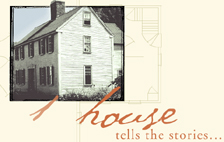talking history | syllabi | students | teachers | puzzle | about us
Within These Walls . . .
http://americanhistory.si.edu/house
Created by the National Museum of American History.
Judith Gradwohl, Website team director; New Tilt, Website Design and Development.
Reviewed Oct. 6–Nov. 11, 2002.
A historic house museum offers visitors a unique way to encounter the past. Because it envelopes the visitor in a space that has meaning, the building itself provides narrative structure—literally and metaphorically—to the interpretation. House museums sometimes fail, however, to link their stories to broader historical themes, for the immediacy of the environment may overwhelm the bigger story. Oddly—since it is virtual—this problem affects the Within These Walls . . . Web site.
Within These Walls . . . (based on a permanent exhibition of the same name) uses a real historic house from Ipswich, Massachusetts, to introduce viewers to “one house, five families, 200 years.” The families were chosen for their ability to open windows onto significant national periods and events (colonial life, the American Revolution, antebellum reform, immigration, and World War II). Each family’s section contains an introduction that connects them and their house to something historically significant: “In the parlor of their home, the Caldwells joined the battle against slavery.” Two short additional paragraphs provide information about family members, their life-styles, and their beliefs or activities. Artifacts help viewers imagine daily life. The most interesting component of each family’s section is a “find out!” feature that brings up a document as evidence. For instance, an 1839 newspaper notice reveals that Mrs. Caldwell hosted an antislavery society meeting at the house.
The Web site cleverly anchors each family’s story to the house, but it misses the opportunity to draw viewers into learning more about the period that the families lived through. The Web site is so skimpy on historical information and analysis that its message seems to be “Can you believe it! Different families lived in this house at different times!” If it was not for the house itself, perhaps the developers would have worked harder to compare the five families or to analyze the relationship between domestic life and national events. But the house gave them a convenient hook to hang their story on, and, perhaps in their excitement at uncovering such a wealth of model families who lived in one house, they forgot to step back and ask, “So what?”
The Web site suffers from other problems as well. The developers used Flash, which impedes navigation (you cannot return to earlier screens) and printing. Fortunately, they also provided a non-Flash version, which many will find easier to use. It is not clear who the site is intended for. The limited amount of text and the guessing games suggest children, but the vocabulary and the concepts suggest adults. A section called “your visit” is not about using the site. Rather, it is about visiting the Smithsonian Institution, although until then it is not obvious that this site is based on an exhibition.
In the end, the Web site suffers from the limitations of trying to use the house as a narrative device and from being a watered-down version of the real exhibition. In its introduction, the Web site suggests that it “tells the stories of five families who lived in this house over 200 years and made history in their kitchens and parlors, through everyday choices and personal acts of courage and sacrifice.” What courage? What sacrifice? Perhaps the exhibition answered those questions, but the Web site does not.
Cynthia Robinson
National Heritage Museum
Lexington, Massachusetts

